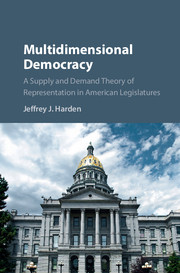Book contents
- Frontmatter
- Dedication
- Contents
- List of Figures
- List of Tables
- Acknowledgments
- 1 Responsiveness Beyond Roll Calls
- 2 A Supply and Demand Theory of Representation
- 3 Citizen Demand for the Dimensions of Representation
- 4 The Determinants of Legislators' Representational Priorities
- 5 Legislative Websites and the Dimensions of Representation
- 6 Unifying the Dimensions of Representation
- Appendix A Appendix to Chapter 3
- Appendix B Appendix to Chapter 4
- Appendix C Appendix to Chapter 5
- References
- Index
Appendix B - Appendix to Chapter 4
Published online by Cambridge University Press: 05 November 2015
- Frontmatter
- Dedication
- Contents
- List of Figures
- List of Tables
- Acknowledgments
- 1 Responsiveness Beyond Roll Calls
- 2 A Supply and Demand Theory of Representation
- 3 Citizen Demand for the Dimensions of Representation
- 4 The Determinants of Legislators' Representational Priorities
- 5 Legislative Websites and the Dimensions of Representation
- 6 Unifying the Dimensions of Representation
- Appendix A Appendix to Chapter 3
- Appendix B Appendix to Chapter 4
- Appendix C Appendix to Chapter 5
- References
- Index
Summary
SURVEY INSTRUMENT
Respondents viewed the constituent e-mail experiment first, then the list experiment.
Constituent E-mail Experiment
All respondents viewed the introductory text first, then were randomly presented with three messages: one each about policy, service, and allocation. The constituent's name was also randomized to signal gender and race (white, black, Latino/a). Recall that the data presented in the main text include only the first treatment message each respondent viewed. I report results from this between subjects design rather than the within-subjects design to avoid problems from respondents learning the aim of the study as they viewed and responded to the three messages in succession.
Introductory Text
You will now see a series of three e-mail messages sent to you from hypothetical constituents. In each one, first read the message. Then answer two questions about each one. First, evaluate the priority level you or your office would give this e-mail if it were sent to you today. Select your evaluation by clicking on a number on the “priority scale” under the message. This measure ranges from 0 to 100, with 0 indicating lowest priority and 100 indicating highest priority. If you would give the message average priority, select the score 50. Second, evaluate how likely you would be able to satisfy the constituent.
Policy Treatment
• Male names: Connor Fredericks, Tyrone Baker, Juan Lopez
• Female names: Molly Wollsteiner, Shanice Jackson, Camila Garcia
Dear Legislator,
My name is [Name] and I want to ask you about public education in our state. I've been hearing how teachers might only get raises if their students get good test scores. Won't that just make teachers afraid to teach in poor schools? What do you think about this, and how do you see it affecting our state?
Thanks,
[Name]
Service Treatment
• Male names: Jacob Nichols, DeAndre Moore, Antonio Ruiz
• Female names: Amy Schneider, Tasheka Robinson, Gabriela Mendez
Dear Legislator,
My name is [Name] and I am having some problems getting a driver's license. The people at the driver's license office say I can't prove I am a resident of the state, but that's not true! I am a resident of the state! I am really tired of dealing with this. Is there anything you can do for me?
Thanks,
[Name]
Information
- Type
- Chapter
- Information
- Multidimensional DemocracyA Supply and Demand Theory of Representation in American Legislatures, pp. 158 - 161Publisher: Cambridge University PressPrint publication year: 2015
